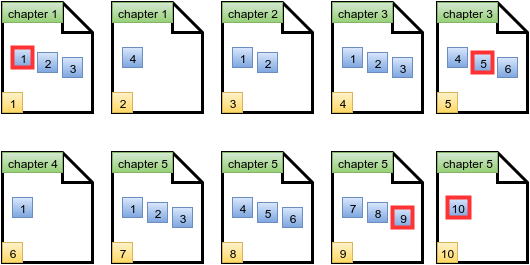Lisa just got a new math workbook. A workbook contains exercise problems, grouped into chapters. Lisa believes a problem to be special if its index (within a chapter) is the same as the page number where it's located. The format of Lisa's book is as follows:
- There are chapters in Lisa's workbook, numbered from to .
- The chapter has problems, numbered from to .
- Each page can hold up to problems. Only a chapter's last page of exercises may contain fewer than problems.
- Each new chapter starts on a new page, so a page will never contain problems from more than one chapter.
- The page number indexing starts at .
Given the details for Lisa's workbook, can you count its number of special problems?
Example
Lisa's workbook contains problems for chapter , and problems for chapter . Each page can hold problems.
The first page will hold problems for chapter . Problem is on page , so it is special. Page contains only Chapter , Problem , so no special problem is on page . Chapter problems start on page and there are problems. Since there is no problem on page , there is no special problem on that page either. There is special problem in her workbook.
Note: See the diagram in the Explanation section for more details.
Function Description
Complete the workbook function in the editor below.
workbook has the following parameter(s):
- int n: the number of chapters
- int k: the maximum number of problems per page
- int arr[n]: the number of problems in each chapter
Returns
- int: the number of special problems in the workbook
Input Format
The first line contains two integers and , the number of chapters and the maximum number of problems per page.
The second line contains space-separated integers where denotes the number of problems in the chapter.
Constraints
Sample Input
STDIN Function ----- -------- 5 3 n = 5, k = 3 4 2 6 1 10 arr = [4, 2, 6, 1, 10]
Sample Output
4
Explanation
The diagram below depicts Lisa's workbook with chapters and a maximum of problems per page. Special problems are outlined in red, and page numbers are in yellow squares.

There are special problems and thus we print the number on a new line.

Post a Comment